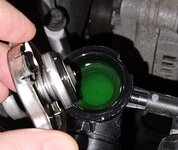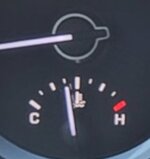- Joined
- Nov 16, 2023
- Messages
- 6
A week ago I did a coolant flush and fill and replaced the thermostat on my 2019 Hyundai Sonata, 4 years old, 62K. After my first trip, once the car had cooled down overnight, the coolant recovery tank was about a cup low, which I expected, as air would be bled out. I topped it off. Since then I’ve taken about 10 trips, and put 450mi on the car. Every couple trips I have to add about 3oz of coolant. I expected by now that I wouldn’t need to do this anymore, and it’s caused me to be concerned. Why?
The initial drain and fill was on a cold engine, but after that, I ran it until it hit operating temp, shut it off, then waiting about 45 min. Things had cooled enough that I could remove the radiator cap, the system wasn’t under pressure. I drained the rad – only about 1.5 qts – and refilled it with distilled water that was about 55 degrees. I closed it up and started the engine. After 10 min I could feel the hoses were warm, so I shut it off and again waited about 45min. I drained the radiator 2 more times, at which point the coolant coming out was pretty diluted, so I then filled it with about 3 qts Prestone concentrate. I checked the coolant in the following days with a plastic/rubber bulb tester, it was reading the correct ratio I was aiming for.
Is there any chance my adding cold water/coolant to a warm system could have damaged something?
The good news: there’s no visible evidence of coolant in the oil. The dipstick and fill cap both look/smell like pure oil. No condensation, bubbles, etc. When I do a cold start, nothing visible comes out of the exhaust pipe. No white or black smoke, no sweet smell. The temp gauge always goes to exactly where it always goes. The car runs perfectly normal.
I did a cold start one morning and inspected all around the thermostat housing (and everywhere else) for any external leaks. No leaks. I don’t know if the system is just continuing to bleed out air, or if I damaged it and it's now going into the oil.
Thoughts?
The initial drain and fill was on a cold engine, but after that, I ran it until it hit operating temp, shut it off, then waiting about 45 min. Things had cooled enough that I could remove the radiator cap, the system wasn’t under pressure. I drained the rad – only about 1.5 qts – and refilled it with distilled water that was about 55 degrees. I closed it up and started the engine. After 10 min I could feel the hoses were warm, so I shut it off and again waited about 45min. I drained the radiator 2 more times, at which point the coolant coming out was pretty diluted, so I then filled it with about 3 qts Prestone concentrate. I checked the coolant in the following days with a plastic/rubber bulb tester, it was reading the correct ratio I was aiming for.
Is there any chance my adding cold water/coolant to a warm system could have damaged something?
The good news: there’s no visible evidence of coolant in the oil. The dipstick and fill cap both look/smell like pure oil. No condensation, bubbles, etc. When I do a cold start, nothing visible comes out of the exhaust pipe. No white or black smoke, no sweet smell. The temp gauge always goes to exactly where it always goes. The car runs perfectly normal.
I did a cold start one morning and inspected all around the thermostat housing (and everywhere else) for any external leaks. No leaks. I don’t know if the system is just continuing to bleed out air, or if I damaged it and it's now going into the oil.
Thoughts?



